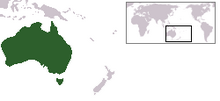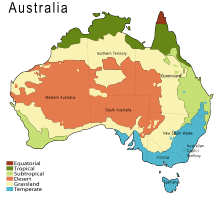This article needs additional citations for verification. (December 2012) |



The Australian environment ranges from virtually pristine Antarctic territory and rainforests to degraded industrial areas of major cities. Forty distinct ecoregions have been identified across the Australian mainland and islands. Central Australia has a very dry climate. The interior has a number of deserts while most of the coastal areas are populated. Northern Australia experiences tropical cyclones while much of the country is prone to periodic drought. This dry and warm environment and exposure to cyclones, makes Australia particularly vulnerable to climate change -- with some areas already experiencing increases in wildfires and fragile ecosystems.
The island ecology of Australia has led to a number of unique endemic plant and animal species, notably marsupials like the kangaroo and koala. Agriculture and mining are predominant land uses which cause negative impacts on many different ecosystems. The management of the impact on the environment from the mining industry, the protection of the Great Barrier Reef, forests and native animals are recurring issues of conservation.
The protected areas in Australia are important sources of ecotourism, with sites like the Great Barrier Reef and World Heritage sites like Tasmanian Wilderness World Heritage Area or the Uluṟu-Kata Tjuṯa National Park draw both national and international tourism. Clean Up Australia Day was an initiative developed in 1989 to collaboratively clean up local areas and is held on the first Sunday of autumn (in March).
© MMXXIII Rich X Search. We shall prevail. All rights reserved. Rich X Search
